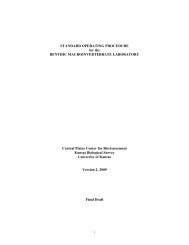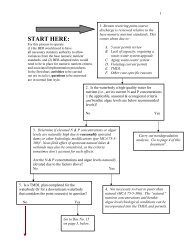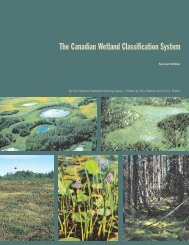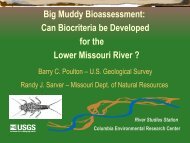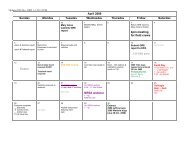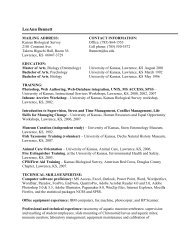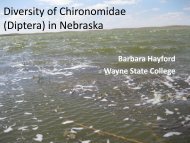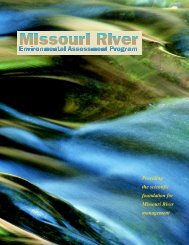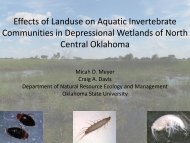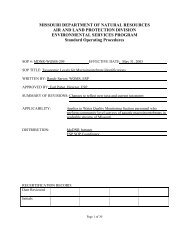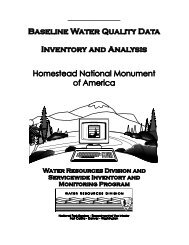Koontz, J., D.G. Huggins, C.C. Freeman, D.S. Baker - Central Plains ...
Koontz, J., D.G. Huggins, C.C. Freeman, D.S. Baker - Central Plains ...
Koontz, J., D.G. Huggins, C.C. Freeman, D.S. Baker - Central Plains ...
You also want an ePaper? Increase the reach of your titles
YUMPU automatically turns print PDFs into web optimized ePapers that Google loves.
a priori Groups and Metric Selection<br />
The stressor-response metrics were selected using a Pearson correlation matrix (i.e. Pearson<br />
product-moment correlation coefficient) and linear regression test, except no single reference or<br />
random group was established a priori. In this study, a priori „high‟ and „low‟ groups were<br />
established for parameters that showed consistent significant responses to multiple<br />
macroinvertebrate metrics using the 25 th and 75 th percentile, since significant variability in<br />
response existed among landscape, plant community, and water quality measures.<br />
Macroinvertebrate metrics were placed in a correlation matrix along with floristic quality<br />
measures, water quality parameters, and surrogate spatial and temporal variables. All significant<br />
(p ≤ 0.05) Pearson correlations were tested with linear regression and retained if still significant.<br />
Relationships were commonly found between various multiple macroinvertebrate metrics and<br />
one water quality measure, floristic quality metric, or other variable. Groups were created as<br />
„least disturbed‟ or „degraded‟ condition with samples having parameter values equal to and<br />
lower or higher than the 25 th or 75 th percentile value, respectively. The macroinvertebrate<br />
metrics that were significantly related to the other environmental parameters through linear<br />
regression analyses were assessed using the two-sample t-test method described by Stoddard et<br />
al. (2008), resulting in 39 macroinvertebrate metric responses to 11 groups, with two groups<br />
eliminated in this process. Many metrics also responded to various groups in the t-test analysis,<br />
thus it was necessary to define each metric by its greatest t-score, further eliminating many a<br />
priori groups.<br />
Twenty-six metrics were retained, the greatest numbers of which were found in the Number of<br />
Herbicides Detected group, Native Plant Richness group, and Maximum Depth group, with a<br />
small representation of other groups having metrics with significant t-scores. Five<br />
macroinvertebrate metrics having the lower t-score between high and low a priori groupings<br />
were eliminated due to redundancy (Pearson R > 0.70) with another macroinvertebrate metric.<br />
Only the Native Plant Richness, Number of Herbicides Detected, and Maximum Depth groups<br />
were further evaluated because they had the greatest response from macroinvertebrate metrics<br />
when metrics also responded to other parameters and groups. These three groups represented<br />
hydrological and floristic wetland qualities as well as anthropogenic disturbance. The remaining<br />
21 metrics were two sample t-tested in these groups.<br />
T-test values remained significant for three metrics in the native plant richness group: Shannon‟s<br />
Diversity Index (+), Percent Burrowers (-), and Count Intolerant Taxa to Suspended Solids and<br />
Sediments (SSS) (+) (Table 12). Four completely different metrics in the maximum depth „high‟<br />
and „low‟ groups were found to be significant in t-test scores: Percent Hydroptilidae (+), Count<br />
ETO taxa (+), Percent Sprawler Taxa (+), and Percent Intolerant based on mean Regional<br />
Tolerance Values (+). The metrics having significant t-test scores between the low and high<br />
Number of Herbicides Detected group were Percent Non-Insect Taxa (-), Percent Burrowers (-),<br />
Intolerant Taxa to Heavy Metals (+), and Count Intolerant Taxa to Suspended Solids and<br />
Sediments (+). These metrics were not significantly (p



